Save 50% on a 3-month Digiday+ membership. Ends Dec 5.

Richemont executive Johann Rupert calls it “the great China opportunity.”
For the first time, the French conglomerate is exploring e-commerce capabilities in the region. Today, the luxury-company-finally-embraces-the-internet story is a tale as old as, well, the internet. But the old guard is gruelingly slow to wake up to the potential of digital sales, and in China, a perfect storm of opportunity has kicked Richemont’s higher-ups into high gear.
And for Richemont, which owns luxury brands like Cartier, Piaget and Van Cleef & Arpels, launching online operations in China is a chance to rebuild.
After a period of overselling through a network of distribution partners in China during a different time when the market was “booming,” according to Rupert, excess inventory flooded the gray market. Luxury watches and jewelry sold at discounts of up to 65 percent. Richemont has spent the past three years buying back all the inventory being sold through third-party channels, in some cases destroying product in order to start over with a clean slate.
“[For years], corruption in China was so rife. Obviously, we had to fight this,” says Rupert. “Today, China has normalized. We plan to lift domestic consumption. We see growth across all luxury goods.”
Richemont is exploring options around moving more inventory online through partners’ luxury-oriented portals, like Tmall’s Luxury Pavilion and JD.com’s Toplife. The strategic shift represents a retreat from wholesale channels and a move toward holistic, cross-channel capabilities.
“We’ve tried to manage [wholesale, retail and e-commerce channels] separately. This is the model of the past,” Richemont CFO Burkhart Grund told investors on a recent call. “The customer doesn’t see wholesale, retail or e-commerce as separate channels. For them, it is all part of the same experience. That is the much bigger challenge the industry is facing. We believe the traditional wholesale trade, especially in watches, will over time disappear.”
Starting over in China is essential today for luxury companies. The Asia-Pacific market (excluding Japan) is seeing growth in the luxury category at a pace that exceeds every other region, and the cohort of millennial luxury shoppers is responsible for a recent spike in luxury spending, according to Bain & Co. For Richemont, the Asia-Pacific market grew by 25 percent year over year in the first half of financial 2018, as reported in November. Overall, it’s responsible for 39 percent of all sales.
Reintroducing Richemont’s portfolio of luxury brands requires a new strategy. According to Alibaba research, China’s luxury shoppers are young, between the ages of 20 and 34, and their lives revolve around their mobile devices. EMarketer predicts that by the end of 2018, 75 percent of e-commerce sales in China, worth over $1 trillion, will be transacted via mobile.
“If companies were to fully understand how much time this customer is spending on their phone, and how much time on their phone is spent shopping, they would be running in this direction,” says James Rogers, the managing director of CR Retail, a retail consultancy firm based in Shanghai. “It’s a way of life.”
In 2017, Richemont made its first official move when Cartier launched e-commerce operations on Chinese mobile platform WeChat, which counts 1 billion active users, and Rupert has told investors it’s considering other ways it can ramp up e-commerce efforts in China.
“WeChat is a major opportunity for a brand like Cartier,” says Liz Flora, the Asia-Pacific research analyst at business intelligence firm L2. “Most brands use it for one-time campaign launches or customer engagement. To launch a store shows a deeper understanding of where customers spend time and money in China today.”
What’s critical for brands to understand about the “China opportunity,” says Flora, is the balance between control and key partnerships. Companies like Alibaba and JD.com are positioning themselves as resources around e-commerce logistics, manufacturing, deliveries and marketing for brands entering the market. WeChat, on the other hand, gives a brand total control to present itself to customers, handle orders and build up customer engagement.
“Richemont, with Cartier, has an incredible resource in front of it,” says Rogers. “It won’t take long for the company to see this as a road map for the rest of its way forward in China. And this time, it might actually be ahead of the curve.”
More in Marketing

In Graphic Detail: CMOs at a crossroads of power and proof
CMOs are closing out another year defined by churn and shifting ground.

As Black Friday nears, fake apologies from brands are all over Instagram
Brands have taken to social media in advance of Bliack Friday to ask followers for forgiveness. The catch: They’re apologizing for their products being too good.

Amid economic pressure, brands usher in Black Friday by trimming deals
While some companies are touting “bigger than ever” discounts for Black Friday and Cyber Monday, others are dialing back deals.





